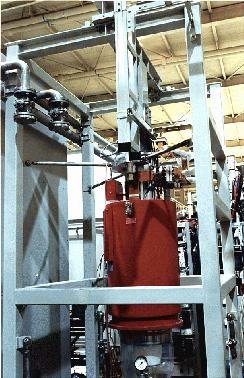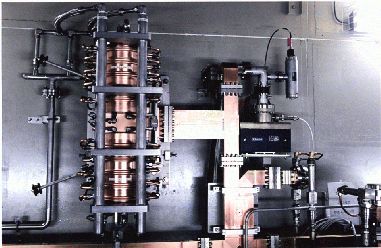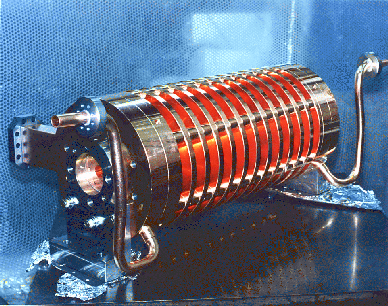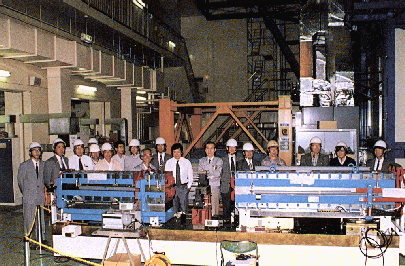Research and Development for JLC
Next generation linear colliders require an acceleration gradient in excess of a few tens of Mega Volts per meter. In order to generate such a high field, we need a high power radio frequency (rf) pulse generator called klystron and a pulse compressor. An rf system that meets the requirements of the phase I machine (300-500GeV in center-of-mass energy) is already available.
- Generation of High Power rf pulse
 A klystron capable of generating a peak power of 100 MW developed at
A klystron capable of generating a peak power of 100 MW developed at
- Times-Five Compression
 A pulse compressor called SLED which was originally invented at Stanford Linear Accelerator Center (SLAC) and has been improved at KEK. This compresses the rf pulse from the high power klystron and increases the peak power by a factor of five. The compressed rf pulse is fed to four accelerating structures to accelerate electrons or positrons.
A pulse compressor called SLED which was originally invented at Stanford Linear Accelerator Center (SLAC) and has been improved at KEK. This compresses the rf pulse from the high power klystron and increases the peak power by a factor of five. The compressed rf pulse is fed to four accelerating structures to accelerate electrons or positrons.
- Multi-Bunch Acceleration
 For the stable acceleration of multi-bunch beams, we need an accelerating structure that keeps the accelerating field inside, while throwing away the wake field induced by the preceding bunches, so that the trailing bunches are not disturbed by the wake field. Such an accelerating structure, called choke mode cavity, has been invented at KEK.
For the stable acceleration of multi-bunch beams, we need an accelerating structure that keeps the accelerating field inside, while throwing away the wake field induced by the preceding bunches, so that the trailing bunches are not disturbed by the wake field. Such an accelerating structure, called choke mode cavity, has been invented at KEK.
- Focusing Beams to the Limit
 A system of precision final focusing magnets developed at KEK. The system is designed to strongly focus beams to the collision point and to stably keep them there. With this system we have already succeeded in producing a 60 nano-meter electron beam (corresponding to 200 times the size of a typical atom) in experiments carried out in collaboration with SLAC(USA), DESY(Germany), Protovino (Russia), etc. Notice that controlling such small beams require an precision active alignment system as shown in the figure above: the tables supporting the magnets are computer-controlled and move actively to cancel vibrations in order to achieve stability of a nano-meter level.
A system of precision final focusing magnets developed at KEK. The system is designed to strongly focus beams to the collision point and to stably keep them there. With this system we have already succeeded in producing a 60 nano-meter electron beam (corresponding to 200 times the size of a typical atom) in experiments carried out in collaboration with SLAC(USA), DESY(Germany), Protovino (Russia), etc. Notice that controlling such small beams require an precision active alignment system as shown in the figure above: the tables supporting the magnets are computer-controlled and move actively to cancel vibrations in order to achieve stability of a nano-meter level.
To next page,
To previous page,
To contents
webmaster@www-jlc.kek.jp Feb 08, 1995
 A klystron capable of generating a peak power of 100 MW developed at
A klystron capable of generating a peak power of 100 MW developed at
 A pulse compressor called SLED which was originally invented at Stanford Linear Accelerator Center (SLAC) and has been improved at KEK. This compresses the rf pulse from the high power klystron and increases the peak power by a factor of five. The compressed rf pulse is fed to four accelerating structures to accelerate electrons or positrons.
A pulse compressor called SLED which was originally invented at Stanford Linear Accelerator Center (SLAC) and has been improved at KEK. This compresses the rf pulse from the high power klystron and increases the peak power by a factor of five. The compressed rf pulse is fed to four accelerating structures to accelerate electrons or positrons.
 For the stable acceleration of multi-bunch beams, we need an accelerating structure that keeps the accelerating field inside, while throwing away the wake field induced by the preceding bunches, so that the trailing bunches are not disturbed by the wake field. Such an accelerating structure, called choke mode cavity, has been invented at KEK.
For the stable acceleration of multi-bunch beams, we need an accelerating structure that keeps the accelerating field inside, while throwing away the wake field induced by the preceding bunches, so that the trailing bunches are not disturbed by the wake field. Such an accelerating structure, called choke mode cavity, has been invented at KEK.
 A system of precision final focusing magnets developed at KEK. The system is designed to strongly focus beams to the collision point and to stably keep them there. With this system we have already succeeded in producing a 60 nano-meter electron beam (corresponding to 200 times the size of a typical atom) in experiments carried out in collaboration with SLAC(USA), DESY(Germany), Protovino (Russia), etc. Notice that controlling such small beams require an precision active alignment system as shown in the figure above: the tables supporting the magnets are computer-controlled and move actively to cancel vibrations in order to achieve stability of a nano-meter level.
A system of precision final focusing magnets developed at KEK. The system is designed to strongly focus beams to the collision point and to stably keep them there. With this system we have already succeeded in producing a 60 nano-meter electron beam (corresponding to 200 times the size of a typical atom) in experiments carried out in collaboration with SLAC(USA), DESY(Germany), Protovino (Russia), etc. Notice that controlling such small beams require an precision active alignment system as shown in the figure above: the tables supporting the magnets are computer-controlled and move actively to cancel vibrations in order to achieve stability of a nano-meter level.